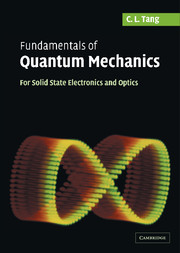Book contents
- Frontmatter
- Contents
- Preface
- 1 Classical mechanics vs. quantum mechanics
- 2 Basic postulates and mathematical tools
- 3 Wave/particle duality and de Broglie waves
- 4 Particles at boundaries, potential steps, barriers, and in quantum wells
- 5 The harmonic oscillator and photons
- 6 The hydrogen atom
- 7 Multi-electron ions and the periodic table
- 8 Interaction of atoms with electromagnetic radiation
- 9 Simple molecular orbitals and crystalline structures
- 10 Electronic properties of semiconductors and the p-n junction
- 11 The density matrix and the quantum mechanic Boltzmann equation
- References
- Index
6 - The hydrogen atom
Published online by Cambridge University Press: 05 June 2012
- Frontmatter
- Contents
- Preface
- 1 Classical mechanics vs. quantum mechanics
- 2 Basic postulates and mathematical tools
- 3 Wave/particle duality and de Broglie waves
- 4 Particles at boundaries, potential steps, barriers, and in quantum wells
- 5 The harmonic oscillator and photons
- 6 The hydrogen atom
- 7 Multi-electron ions and the periodic table
- 8 Interaction of atoms with electromagnetic radiation
- 9 Simple molecular orbitals and crystalline structures
- 10 Electronic properties of semiconductors and the p-n junction
- 11 The density matrix and the quantum mechanic Boltzmann equation
- References
- Index
Summary
The hydrogen atom is the Rosetta stone of the early twentieth century atomic physics. The attempt to decipher its structure and properties led to the development of quantum mechanics and the unraveling of many of the mysteries of atomic, molecular, and solid state physics, and a good deal of chemistry and modern biology. Unlike the various one-dimensional model problems that we have been studying in the previous chapters, the hydrogen atom is a real physical system in three dimensions. It consists of an electron moving in a spherically symmetric potential well due to the Coulomb attraction of the positively charged nucleus. In three dimensions, the electron is not constrained to move linearly. It can execute orbital motions and, thus, has angular momentum. Not only is the total energy of the electron in the atom quantized, its angular momentum also has interesting and unexpected quantized properties that cannot possibly be understood on the basis of classical mechanics and electrodynamics. They are, however, the natural and necessary consequences of the basic postulates of quantum mechanics, as will be shown in this chapter.
According to classical mechanics and electrodynamics, it is not possible to have a stable structure consisting of a small positively charged nucleus at the center of an electrically neutral atom with an electron sitting in its vicinity. For the electron not to be attracted into the positive charge, it must be orbiting around the nucleus so that the centrifugal force will counter the Coulomb attraction of the nucleus and maintain a constant electron orbit.
- Type
- Chapter
- Information
- Fundamentals of Quantum MechanicsFor Solid State Electronics and Optics, pp. 86 - 109Publisher: Cambridge University PressPrint publication year: 2005



